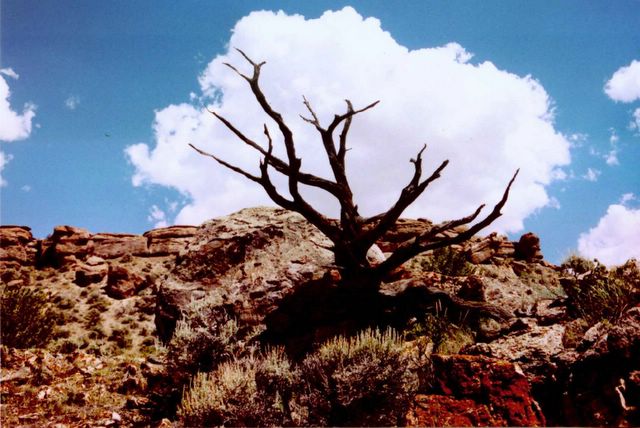Note: between Wednesday, April 27 and Friday, April 30, which is arbor day, this blog will be devoted to trees. Why don't you celebrate by planting a tree? Please comment and tell me about your special trees. If you're so inspired by this post that you can't wait for tomorrow's post, you can look at my tags for trees and treehouses.)
I’ve noticed that Wesley’s Christmas tree (that blue spruce next to the East driveway of the church) has been putting out bright green new branches lately. That tree has been in the ground for four years now. Blue Spruce are known to be slow growers, and the tree has only grown a six inches a year or so. I’ve recently Julianna’s 2nd Christmas tree too. (We bought tabletop trees to plant for Christmas when the children were two—we found it easier to keep ornaments on the tree). Wesley’s tree’s growth is especially noticeable because it sits next to Julianna’s tree—which has not yet put out any new growth. I haven’t been able to find any information as to whether this is to be expected with a new tree that was just put in the ground in January, so if there are any horticulturists out there who have good advice, let me hear it because I’m worried about it!
Scriptures say that God expects and hopes for us to show new growth in our Spirits. Much is said in the Psalms and Prophets about fruitfulness and it is a major theme of Paul’s letters to the church. Paul encourages the believers to bear fruit in their spiritual lives. Just to make things clear, Paul spells out how that looks on a practical level. “But the fruit of the Spirit is love, joy, peace, patience, kindness, goodness, faithfulness, gentleness and self-control. Against such things there is no law.” (Gal 5: 22-23)
Jesus speaks of the urgency of us bearing fruit in prophetic action, recorded in Mark 11 and Matthew 21. Jesus walks up to a fig tree (which Mark says is “not in the fruit bearing season, but had leaves”) and finds that it has borne no figs. He curses the tree, and the disciples watch in amazement as the tree withers from the root. I’ve always felt sorry for that poor fig tree. It seems so out of character for Jesus to curse and hurt a living thing. I took this question to Brother Aidan, a hermit monk I had the opportunity to stay with for a week around 10 years ago. He spoke about the importance of bearing fruit when we have an encounter with Jesus. It’s not good enough just to just be in proximity to Jesus, we must respond to that presence. Whatever we are called by God to do, even yield fruit out of season or tell a mountain to throw itself into the sea, we must be bold enough do it.
But I’m not the only one who has a soft spot for the fig tree. This is one of those interesting stories that is contained in Mark (which Matthew and Luke utilized to compose their own Gospels) that Matthew adapted, but Luke left out entirely. Actually Luke doesn’t leave it out, he simply rewrites it as a parable. In Luke 13: 1-9, Jesus tells the story of a man who has a fig tree planted in his vineyard, and seeks fruit from it, but finds none for three years, and then tells his servant to cut it down. The servant then pleads with the landowner to spare the tree for another year, in which he will tend it carefully, putting manure at its roots, and then see if it will finally produce fruit. Tradition says that Luke was a physician. Perhaps he just couldn’t see Jesus cursing a tree because of his own interest in helping people recover from injury and disease. Instead, he recounts Jesus being the servant. He’s here to tend to the tree and stave off destruction. Still, urgency is implied in Luke’s story as well.
I like Luke’s story much better than Matthew and Mark. I can see Aidan’s point about the urgency and necessity of complying with God’s call on us, but I think Luke’s picture is more in harmony with Jesus as Master Physician and Finder of Lost Sheep. I think God looks at us with the same sympathy and hope that I look at my kids’ two Christmas trees. I see the one putting out new lush green branches, and I see the other looking more brown and brittle by comparison. Instead of being angry with brittle tree, I wonder what more I can do to help it become vibrant and growing.







No comments:
Post a Comment